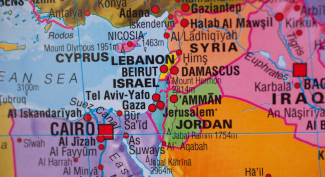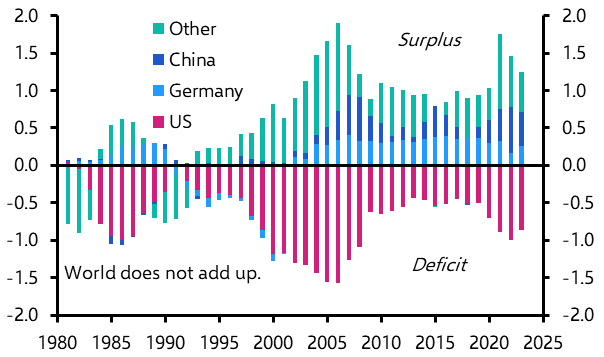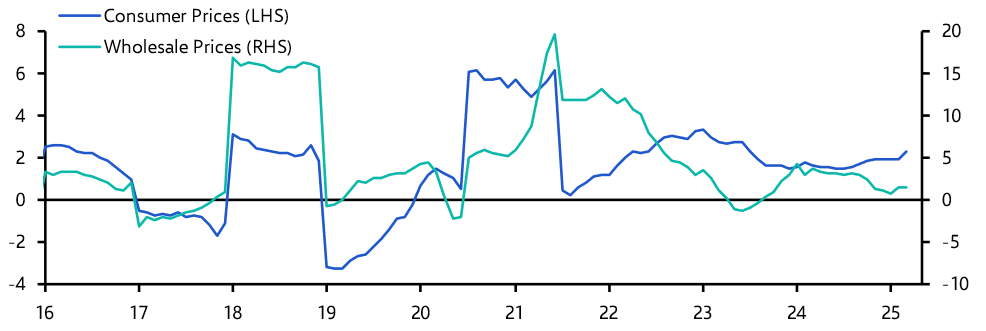
The Middle East and North Africa
Our Middle East and North Africa coverage provides detailed analysis, independent forecasts, and regional outlooks for the economies and financial markets across the region. We offer rapid responses to new data and developments, along with in-depth coverage of key themes, current trends, and future economic dynamics.
This service offers in-depth economic analysis of growth, inflation, trade, currency and interest rate trends and independent market forecasts for 12 MENA states: Saudi Arabia, Egypt, United Arab Emirates, Algeria, Qatar, Kuwait, Morocco, Oman, Tunisia, Lebanon, Jordan and Bahrain.
The subscription to this service includes 4-5 publications a week, access to our online research archive and our economists, and the opportunity to attend our conferences, forums and webinars.
- Authoritative research by proven experts.
- Contrarian calls and thought-provoking analysis.
- Rapid responses, concise summations, detailed analysis, & independent forecasts.

Read our latest Economic Outlook
Our latest Economic Outlook for the Middle East and North Africa is the place to read all of our updated key calls and view our forecasts for the region. You can also view this data in our interactive Macro Dashboard with historical data and Capital Economics forecasts you need to track.
Saudi's Vision 2030: where it's going right (and wrong)
Saudi Arabia’s Vision 2030 reform programme is passed its halfway point with clear evidence of major societal and cultural changes. But the authorities are currently on track to miss many of their economic targets.
What are the implications of missing these targets, and what is the outlook for Saudi in a world of falling oil demand? These questions, and more, are answered in our in-depth Focus and we answered client questions in a Drop-in session.


Try for free
Experience the value that Capital Economics can deliver. With complimentary access to our subscription services, you can explore comprehensive economic insight, data and charting tools, and attend live virtual events hosted by our economists.

Key Research on Tensions in the Middle East
Syria after Assad |
The implications of the Israel-Hezbollah ceasefire |
Nasrallah and the next phase of war in the Middle East |
|
The fall of Syria's President Assad has been warmly received by many, but a key lesson from the Arab Spring is that hopes for a major shift to democracy are thin. What's more, the geopolitical allegiances in the region are far different than at the height of the Civil War and may cloud the direction of Syria's outlook. |
For now, the economic impact of the ceasefire will hinge on whether it can pave the way to a broader de-escalation in the region. But for Lebanon, at least, an opportunity is growing for the government to come together and enact critical reforms to pull the economy out of its deep economic crisis. |
September's strike by Israeli forces that killed Hezbollah leader Hassan Nasrallah represented a major escalation in hostilities. On its own this may threaten oil supplies and, in turn, oil prices and global inflation. But it comes as OPEC+ looks set to start raising supply in 2025. |
| Start reading | Start reading | Start reading |
Key Regional Forecasts
These are our latest forecasts for GDP growth and inflation across the Middle East and North Africa. For more detail behind these, view our latest Economic Outlook.
GDP and Consumer Prices (% y/) |
|||||||||||
|
GDP |
Consumer Prices |
||||||||||
|
Share of World1 |
2023 |
2024 |
2025 |
2026 |
2027 |
2023 |
2024 |
2025 |
2026 |
2027 |
|
|
Saudi Arabia |
1.09 |
-0.8 |
1.3 |
4.3 |
2.5 |
2.0 |
2.3 |
1.7 |
2.0 |
0.5 |
1.5 |
|
Egypt |
1.15 |
2.9 |
3.1 |
5.8 |
6.3 |
5.3 |
34.0 |
28.0 |
11.3 |
8.3 |
8.0 |
|
UAE |
0.44 |
3.6 |
4.0 |
4.5 |
5.0 |
4.3 |
1.8 |
1.8 |
1.8 |
1.3 |
0.5 |
|
Algeria |
0.43 |
4.1 |
3.0 |
1.5 |
1.8 |
1.8 |
9.3 |
4.0 |
3.5 |
4.3 |
4.5 |
|
Morocco |
0.20 |
3.4 |
3.3 |
5.5 |
5.3 |
5.3 |
6.1 |
0.9 |
2.0 |
2.3 |
2.5 |
|
Qatar |
0.18 |
1.5 |
2.8 |
2.8 |
13.0 |
7.8 |
3.1 |
1.2 |
0.8 |
1.3 |
0.8 |
|
Kuwait |
0.13 |
-1.7 |
-3.3 |
1.0 |
3.8 |
2.0 |
3.6 |
2.9 |
2.3 |
2.0 |
1.3 |
|
Oman |
0.11 |
1.2 |
1.7 |
2.8 |
2.5 |
3.8 |
1.0 |
0.5 |
1.8 |
1.0 |
0.8 |
|
Tunisia |
0.09 |
0.0 |
1.4 |
2.0 |
1.0 |
2.0 |
9.3 |
7.0 |
7.5 |
9.3 |
8.8 |
|
Jordan |
0.06 |
2.6 |
2.5 |
2.3 |
1.5 |
1.5 |
2.1 |
1.6 |
2.0 |
0.3 |
0.3 |
|
Bahrain |
0.05 |
3.9 |
0.8 |
3.5 |
1.8 |
2.0 |
0.1 |
0.9 |
0.0 |
2.3 |
2.0 |
|
Lebanon |
0.04 |
-1.0 |
-8.0 |
-0.5 |
5.0 |
5.3 |
221.3 |
45.2 |
12.5 |
8.5 |
7.5 |
|
MENA |
3.97 |
1.6 |
2.2 |
4.2 |
4.4 |
3.8 |
14.3 |
10.0 |
5.0 |
3.7 |
3.8 |
|
Sources: CEIC, LSEG Data & Analytics, Capital Economics. 1) %, 2024, in PPP terms. |
|||||||||||
Featured Economists
-

James Swanston
Senior Middle East and North Africa Economist
James is a Senior Economist in our Emerging Markets team at Capital Economics, specialising in coverage of the Middle East and North Africa (MENA). James joined Capital Economics in 2017 and has covered MENA since 2019, in which time his research has included deep dives into the debts of Dubai's government related-entities and the risks facing the Egyptian pound. James is frequently quoted in global and local media, including in the Financial Times, the Wall Street Journal, Reuters, and Arab News. James holds a BSc in Economics from the University of Bath and an MSc in Economic History from the London School of Economics and Political Science where his research focused on the historical role of the IMF in Egypt.
-

Jason Tuvey
Deputy Chief Emerging Markets Economist
Jason Tuvey is our Deputy Chief Emerging Markets Economist, working closely with William Jackson to oversee our coverage of Emerging Europe, Latin America, the Middle East and Africa. Jason joined Capital Economics in 2012 and has developed a strong track record in that time. He currently produces our day-to-day research on Mexico and, before that, established himself as one of the world’s foremost analysts of Turkey’s economy and financial markets, winning multiple forecast accuracy awards from Refinitiv, Focus Economics and Consensus Economics. Jason regularly engages with clients to deliver our latest insights on developments in the emerging world. Jason’s research has spanned a wide variety of topics, including debt restructuring talks in Sub-Saharan Africa, economic reforms in Saudi Arabia and the implications of unorthodox policymaking in Turkey. Jason regularly presents to clients and has been widely quoted by the world’s leading media organisations, including the Financial Times, The Wall Street Journal and Bloomberg. He holds a degree in Economics from the University of Bath.























